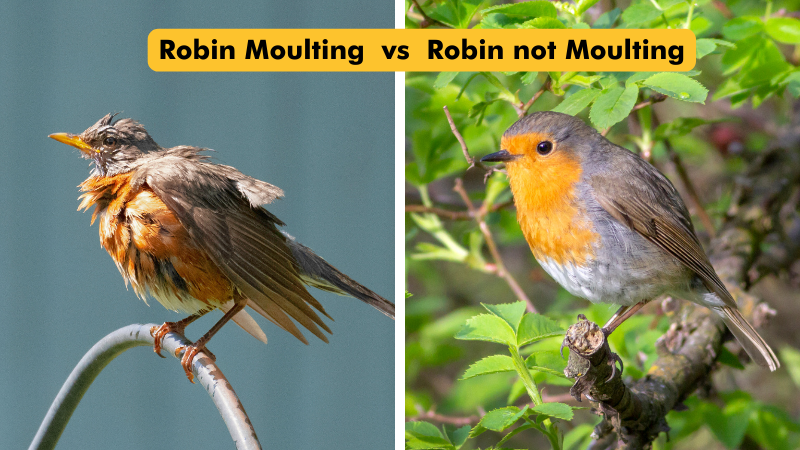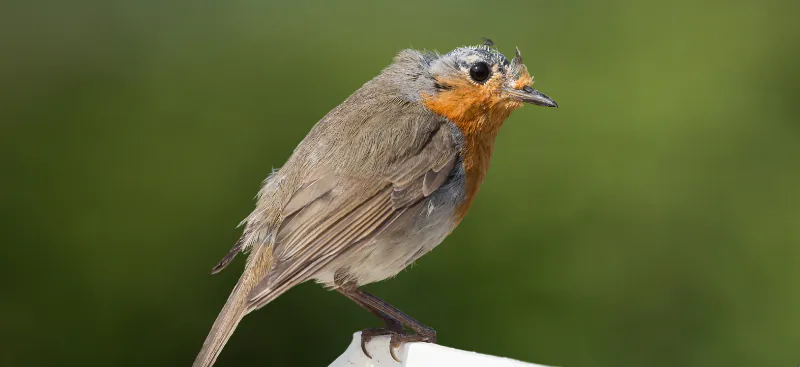Moult in Birds: Why Do Garden Birds Lose Their Feathers?
Picture this: a serene garden with a symphony of chirping birds, each flaunting their vibrant plumage as they flit from branch to branch. But have you ever wondered why those dazzling feathers sometimes seem to vanish, leaving behind moulting birds looking a tad worse for wear? Fear not, for we're about to delve into the avian world of transformation: the phenomenon known as moulting.
What is moulting in birds?
Moulting in garden birds is a natural biological process in which birds shed and replace their old, worn or damaged feathers with new ones. This process is essential for the health, survival, and overall well-being of birds. Just like humans and many other animals shed their hair or skin, birds shed their feathers. Moulting can occur for several reasons.
- Worn-out Feathers: Feathers are crucial for birds as they provide insulation, enable flight, and play a role in various behaviours like courtship displays. Over time, feathers can become damaged, frayed, or worn due to exposure to the elements, physical wear and tear, and preening. Moulting allows birds to replace these worn feathers with new ones, maintaining their feather quality.
- Seasonal Changes: Many birds moult in response to seasonal changes. For instance, after the breeding season, when birds may have expended a lot of energy raising chicks, they may moult to replace their feathers in preparation for the challenges of the upcoming winter months. The timing of moulting can vary depending on the species, climate, and environmental conditions.
- Maturation: Young birds often have juvenile plumage that is different from the plumage of adults. As they mature, they undergo moulting to replace their juvenile feathers with the adult feathers characteristic of their species. This transition from juvenile to adult plumage is a significant part of their development.
- Hormonal Changes: Moulting is influenced by hormonal changes in birds. Hormones signal the body to shed old feathers and stimulate the growth of new ones. These hormonal changes are often linked to factors like daylight duration and the bird's physiological state.
Moulting is a carefully timed process to ensure that birds do not become completely flightless during the process. Different feathers are shed and replaced in a specific sequence to ensure the moult bird can still fly and maintain its essential functions. Flight feathers, which are crucial for flying, are usually replaced in pairs so that the bird can still remain airborne while undergoing the moult.
What do birds look like when they moult?
When birds are going through the moult, their appearance can change noticeably. It's common for many people to mistake their garden birds are ill or diseased, as moulting can have scruffy or patchy appearances due to the shedding and regrowth of feathers. The specific changes in their appearance can vary based on the stage of moult, the type of feathers being replaced, and the species of the bird.

Do all birds moult?
Yes, all birds undergo moulting at some point in their lives. The moulting process varies based on the bird's species, age, and the time of the year. However, it's common for most birds to experience a complete moult within a year. This process might be divided into two or three distinct phases, often occurring before and after the breeding season.
For smaller birds, moulting takes around five weeks. During this period, they shed and regrow their flight feathers, ensuring they remain ready for their aerial escapades. Interestingly, migratory species seem to be the champions of speed in this feathered makeover game, as they manage to complete their moulting process the fastest.
What month do birds moult?
Just like we update our wardrobes with the changing seasons, birds moult to replace worn-out feathers and sport new, fresh ones. Think of it as their way of saying, "Out with the old, in with the new!"
Even though moulting can occur any time of year for birds, August steals the spotlight as prime time for bird moulting season. As the weather hits its peak warmth, this season offers the ultimate chance for our avian friends to partake in this transformative process. If moulting occurred earlier or later in the year, they'd find themselves without their cosy, insulating feathers and feel quite chilly.
How do you help garden birds through a moult?
Assisting garden birds during their moult can be a kind and supportive endeavour. Here are some ways you can provide help during this transitional period:
- Provide Nutritious Food: Offer a variety of high-quality bird foods, such as seeds, suet, mealworms, and fruit. These provide the essential nutrients birds need for feather growth and overall health. Moulting requires energy, so offering energy-rich foods like suet can be particularly beneficial.
- Fresh Water Source: Keep a clean and accessible water source, like a birdbath, where birds can bathe and drink. Clean feathers are healthier feathers, and bathing aids in preening and maintaining plumage.
- Minimise Disturbances: During moult, birds might be more vulnerable due to their compromised feathers. Minimise disturbances around bird feeding and resting areas to reduce stress.
- Offer Shelter: Nest boxes, plants and shrubs can provide shelter from inclement weather and predators. Having evergreen plants and nest boxes can be particularly beneficial, offering year-round cover.
- Be Patient: Understand that moulting is a natural process and can take some time. Continue offering support and resources throughout the moulting period.

